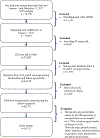Potentially Harmful Medication Prescribing by the Degree of Physician Specialization in Nursing Home Practice: An Observational Study
- PMID: 37088104
- PMCID: PMC10524654
- DOI: 10.1016/j.jamda.2023.03.017
Potentially Harmful Medication Prescribing by the Degree of Physician Specialization in Nursing Home Practice: An Observational Study
Abstract
Objectives: The use of anticholinergics, antipsychotics, benzodiazepines, and other potentially harmful medications (PHMs) is associated with particularly poor outcomes in nursing home (NH) residents with Alzheimer's disease and related dementias (ADRD). Our objective was to compare PHM prescribing by NH physicians and advanced practitioners who focus their practice on NH residents (NH specialists) vs non-NH specialists.
Design: Retrospective cohort study.
Setting and participants: We included a 20% random sample of Medicare beneficiaries with ADRD who resided in 12,278 US NHs in 2017. Long-stay NH residents with ADRD were identified using MDS, Medicare Parts A and B claims. Residents <65 years old or without continuous Part D coverage were excluded.
Methods: Physicians in generalist specialties and advanced practitioners with ≥90% of Part B claims for NH care were considered NH specialists. Residents were assigned to NH specialists vs non-NH specialists based on plurality of Part D claims submitted for that resident. Any PHM use (defined using the Beers Criteria) and the proportion of NH days on a PHM were modeled using generalized estimating equations. Models included resident demographics, clinical characteristics, cognitive and functional status, behavioral assessments, and facility characteristics.
Results: Of the 54,713 residents in the sample, 27.9% were managed by an NH specialist and 72.1% by a non-NH specialist. There was no statistically significant difference in any PHM use [odds ratio (OR) 0.97, 95% CI 0.93-1.02, P = .23]. There were lower odds of prolonged PHM use (OR 0.87, 95% CI 0.81-0.94, P < .001, for PHM use on >75% vs >0%-<25% of NH days) for NH specialists vs non-NH specialists.
Conclusions and implications: Although the use of PHMs among NH residents with ADRD managed by NH specialists was not lower, they were less likely to receive PHMs over longer periods of time. Future work should evaluate the underlying causes of these differences to inform interventions to improve prescribing for NH residents.
Keywords: Potentially harmful medications; antipsychotics; nursing home; physicians; specialization.
Copyright © 2023 AMDA – The Society for Post-Acute and Long-Term Care Medicine. Published by Elsevier Inc. All rights reserved.
Conflict of interest statement
Figures


Similar articles
-
Mental Health Treatment Among Nursing Home Residents With Alzheimer's Disease and Related Dementias.J Am Med Dir Assoc. 2024 Aug;25(8):105088. doi: 10.1016/j.jamda.2024.105088. Epub 2024 Jun 14. J Am Med Dir Assoc. 2024. PMID: 38885931
-
Antibiotic Prescribing Patterns for Urinary Tract Infections and Pneumonia by Prescriber Type and Specialty in Nursing Home Care, 2016-2018.J Am Med Dir Assoc. 2024 May;25(5):769-773.e9. doi: 10.1016/j.jamda.2024.01.019. Epub 2024 Feb 27. J Am Med Dir Assoc. 2024. PMID: 38428833 Free PMC article.
-
Nursing Home Characteristics Associated with High and Low Levels of Antipsychotic, Benzodiazepine, and Opioid Prescribing to Residents with Alzheimer's Disease and Related Dementias: A Cross-Sectional Analysis.J Am Med Dir Assoc. 2022 Nov;23(11):1780-1786.e2. doi: 10.1016/j.jamda.2022.05.025. Epub 2022 Jun 27. J Am Med Dir Assoc. 2022. PMID: 35772472 Free PMC article.
-
Postacute care outcomes and medicare payments for patients treated by physicians and advanced practitioners who specialize in nursing home practice.Health Serv Res. 2019 Jun;54(3):564-574. doi: 10.1111/1475-6773.13138. Epub 2019 Mar 20. Health Serv Res. 2019. PMID: 30895600 Free PMC article.
-
Factors Associated with Potentially Harmful Medication Prescribing in Nursing Homes: A Scoping Review.J Am Med Dir Assoc. 2022 Sep;23(9):1589.e1-1589.e10. doi: 10.1016/j.jamda.2022.06.008. Epub 2022 Jul 20. J Am Med Dir Assoc. 2022. PMID: 35868350 Free PMC article.
Cited by
-
Approaches to Identify Nursing Home Specialists Using Medicare Claims Data.Med Care. 2025 Jul 1;63(7):520-528. doi: 10.1097/MLR.0000000000002161. Epub 2025 Apr 28. Med Care. 2025. PMID: 40307676
-
Global prevalence of polypharmacy and potentially inappropriate medication in older patients with dementia: a systematic review and meta-analysis.Front Pharmacol. 2023 Aug 24;14:1221069. doi: 10.3389/fphar.2023.1221069. eCollection 2023. Front Pharmacol. 2023. PMID: 37693899 Free PMC article.
References
-
- Magaziner J, German P, Zimmerman SI, et al. The prevalence of dementia in a statewide sample of new nursing home admissions aged 65 and older: diagnosis by expert panel. Epidemiology of Dementia in Nursing Homes Research Group. Gerontologist. Dec 2000;40(6):663–72. doi:10.1093/geront/40.6.663 - DOI - PubMed
Publication types
MeSH terms
Grants and funding
LinkOut - more resources
Full Text Sources
Medical
Research Materials
Miscellaneous

